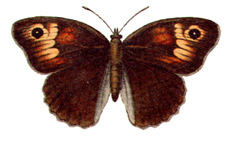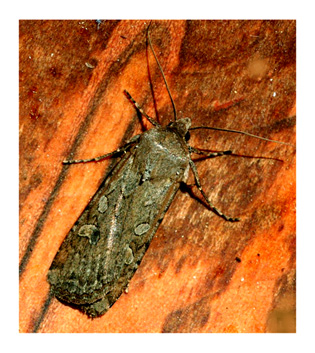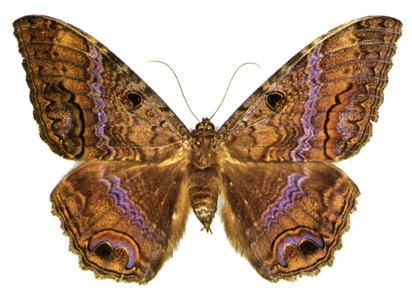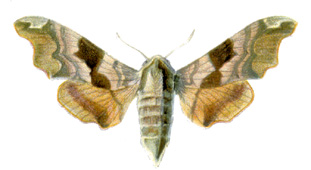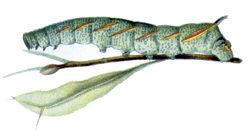Butterflies and Moths in Nabokov's Published Writings
Alphabetical Order ‒ Page 6
Macroglossum stellatarum (Hofmann 1894)
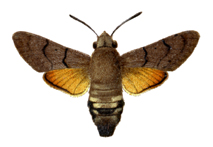
Macroglossum stellatarum Linnaeus, 1758 [Sphingidae, Macroglossinae]: a migratory day-flying hawk moth that breeds in the warmer parts of the Palearctic and then proceeds north. It is such an exceptional flyer that it may even reach the polar zone. As the pupa does not stand freezing temperatures, it will only accidentally survive the winter in the colder zones; next year, the northerly population will be made up of new migrants. The wingspan is 40–50 mm. The tip of its abdomen resembles a short and chubby tail. The Hummingbird Moth darts from flower to flower, sucking nectar with its long proboscis while hovering over it. It is found all over Europe, N Africa and Asia; recently it also reached N America.
Karges (1985) believes the reference in Speak, Memory ("the vibrational halo around the streamlined body of an olive and pink Hummingbird moth poised in the air above the corolla") to be to all hawk moths that hover like hummingbirds and for no apparent reason identifies this particular one as Proserpinus proserpina Pallas, 1772. If so, 'Hummingbird' would hardly have been capitalized.
*Gift 133; SpeakM 134; Lol 157; Ada 510; N/WLet #231=191old; Lep2 255
& Ac: Macroglóssum stellatárum • En: Hummingbird Moth • Fr: le moro-sphinx • Ge: Taubenschwänzchen, Karpfenschwanz • It: sfinge del galio, passera dei morti • Ru: языкан мареновый • Sp: esfinge colibrí, esfinge moro
& Ac: Prosérpinus prosérpina • En: Willowherb Hawk Moth • Fr: le sphinx de l'épilobe • Ge: Nachtkerzenschwärmer • Ru: бражник Прозерпина • Sp: esfinge proserpina
Maculinea (ex Lycaena, ex Phengaris) alcon Denis & Schiffermüller, 1775 [Lycaenidae, Polyommatinae, Polyommatini, Glaucopsyche Section]: a blue with a violet lustre in the males. The females are blue only on the inner parts of their wings while their wide margins are brown. The wingspan is about 35 mm. The range is from N Portugal through N Spain, France, most of C and parts of E and S Europe, Asia Minor and E through temperate Asia to E Siberia, Kazakhstan, Mongolia and Altai. Its caterpillar lives in obligatory symbiosis with ants.
*StrOps 332; NabBut 606 (BE)
& Ac: Maculínea/Lycáena álcon • En: Alcon (Blue) • Fr: l'azuré de la croisette • Ge: Kleiner Moorbläuling, Moos(enzian)bläuling, Enzian-Ameisenbläuling • Ru: малая торфяниковая голубянка • Sp: hormiguera
Maculinea arion (Lampert 1907)
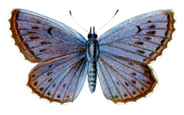
*Maculinea (ex Lycaena, Phengaris) arion Linnaeus, 1758 [Lycaenidae, Polyommatinae]: This probably is the blue of The Gift said to have "concluded a barbaric pact with [the inhabitants of an ant-hill]". It is a Palearctic lycaenid whose range extends from the N of the Iberian Peninsula through most of C Europe to Fennoscandia and E across temperate Asia to Mongolia. Its caterpillar feeds first on thyme and then lets itself be carried into an ant-hill where it feeds on ant larvae, secreting a sweet juice to pacify the ants. It is a symbiotic practice widespread among blues, but particularly within the genus Maculinea van Eecke 1915, having earned it the German surname 'Ameisenbläulinge' (ant blues). (For ant blues, see under »blues.)
*Gift 110; NabBut 606 (BE); Lep2 270
& Ac: Maculínea/Lycáena aríon • En: Large Blue • Fr: l'arion, l'azuré du serpolet • Ge: Schwarzfleckenbläuling, Arionbläuling • Ru: голчбянка Арион • Sp: hormiguera de lunares
Maculinea (ex Lycaena, Phengaris) nausithous Bergsträsser, 1779 [Lycaenidae, Polyommatinae]: the Dusky Large Blue, very rare and local in N Spain, E France, C Europe, Turkey, Caucasus, C and S Urals, Altai. "Both nausithous and teleus [»Maculinea telejus] frequent marshes and like to settle on the dense brownish flower-clusters of the tall herb Sanguisorba officinalis."
*NabBut 606 (BE)
Maculinea (ex Lycaena, Phengaris) rebeli Hirschke, 1904 [Lycaenidae, Polyommatinae]: one of the ant blues which in their caterpillar stage live in ant nests. The blue in its males is without the frequent violet tinge; it has broad black margins. It is found locally on dry mountain meadows in N Spain, Italy, SC and SE Europe, but especially in the Massif Central of France and in the French Alps.
*StrOps 332
& Ac: Maculínea rébeli • Fr: l'azuré de la croisette, l'azuré de Rebel • Ge: (Rebels) Kreuzenzianbläuling
Maculinea (ex Lycaena, Phengaris) telejus Bergsträsser, 1779 [Lycaenidae, Polyommatinae]: the Scarce Large Blue, very rare and local, often occurring with »Maculinea nausithous, the Dusky Large Blue, in Pyrenees, C Europe, Caucasus, C and S Urals, Kazakhstan, Siberia, Mongolia, N China, Korea, Japan.
*NabBut 606 (BE)
Madeleinea (ex Itylos, Lycaena) koa Druce, 1876 [Lycaenidae, Polyommatinae, Polyommatini, Polyommatus Section]: a S American blue, from the Ecuadorian Andes to C Peru. See under »Itylos. "Itylos Koa Druce" (in Selected Lettters, p. 55) is a misspelling.
*SelLet 55; Lep9 42–43
Madeleinea (ex Itylos, Cupido, Lycaena) moza Staudinger, 1894, syn babhru Weeks, 1901, rubberothei Weeks, 1902 [Lycaenidae, Polyommatinae, Polyommatini, Polyommatus Section]: a S American blue, in the High Andes of Peru, Bolivia, Chile and NW Argentina. See under »Itylos.
*Lep9 40–41
Madeleinea (ex Itylos) pacis Draudt, 1921 [Lycaenidae, Polyommatinae, Polyommatini, Polyommatus Section]: a South American blue, in Peru. See under »Itylos.
*Lep9 44–42
magdalena: »Erebia magdalena
Mamestra Ochsenheimer, 1816: a genus of »Noctuidae, subfamily Noctuinae. The type-species is Mamestra brassicae Linnaeus, 1758, the Cabbage Moth.
*Lep2 257
|
Maniola jurtina (Sepp 1762 ) |
Bosch: The Garden of Delights (right panel: Hell), detail |
|
|
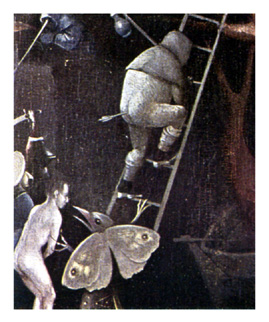 |
Maniola (ex Epinephele, Erebia) jurtina Linnaeus, 1758, syn janira Linnaeus, 1758 [Nymphalidae, Satyrinae, Maniolini]: a very common butterfly from the Canary Islands and NW Africa through most of Europe and Asia Minor to Iraq, iran and W Siberia. Its wingspan is 40–48 mm. M. jurtina is medium brown and orange and has a black ringed eyespot in the apex of the forewings.
Nabokov (in a letter to Life, 12 Nov 1949) identified the butterfly wings in the center of the right-hand panel of Bosch's "Garden of Delights" as belonging to the female of Maniola jurtina. Its steely wings will be found in the right-hand panel ("Hell") at the bottom of the ladder leading up to the cave in the viscera; they seem to serve one of hell's armored animals as mock-angelic wings.
*LaughD 201; StrOps 60; Ada 436; SelLet 93–94; NabBut 625 (I); Lep1 32; Lep2 270
& Ac: Maníola/Epinéphele jurtína • En: Meadow Brown • Fr: le myrtil • Ge: Kuhauge, Großes Ochsenauge • It: iurtina • Ru: бархатница волоокая • Sp: loba
Mann's White: one of the English common names of »Pieris mannii.
Marica Hübner, 1819 (not Monica): an abandoned genus of »Nymphalidae, subfamily Satyrinae, tribe Erebiini (US alpines, GB ringlets and arguses). The type-species was »Erebia meolans.
*NabBut 590–2 (BE)
Meadow Brown: the English common name of »Maniola jurtina
Medusia Verity, 1953: an abandoned genus of »Nymphalidae, subfamily Satyrinae, tribe Erebiini (US alpines, GB ringlets and arguses). The type-species was Erebia medusa Denis & Schiffermüller, 1775, the Woodland Ringlet, in C and SE Europe, Turkey, Transcaucasia, S Siberia, Mongolia, N China, from 300–2,300 m.
*NabBut 590–2 (BE)
Megathymus yuccae, from Del Rio, Texas (Howe 1975)
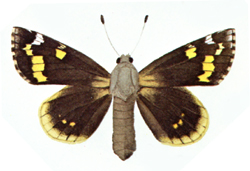
Megathyminae J.H. & A. Comstock, 1895: the giant skippers, a small subfamily of »Hesperiidae (skippers), consisting of twenty-eight species in three genera, all of them in N America, mostly in the SW United States and in Mexico. Their wingspan is 44 to more than 76 mm. They are very fast flyers, said to reach almost 100 kmh. Their triangular wings are mostly brown or black. The caterpillars feed on yucca, agave and manfreda. Nabokov called them "the most noble animals in America". The type-species of the genus Megathymus Scudder, 1872 is Megathymus yuccae Boisduval & Leconte, 1834, the Yucca Skipper, described from North Carolina, ranging from that state westward to California and southward to Mexico (Tamaulipas, Nuevo Leon, Sonora and Baja California). It is the most widely distributed giant skipper. There are many distinct local populations. The caterpillars feed on yuccas, either on the leaves or in the trunks, boring holes up to 60 cm in length. The adults don't seem to feed at all.
*Ada 385
& Am: giant skippers, yucca skippers • Fr: (Ada) l'Hespérie géante • Ge: *Riesen-Dickkopffalter
Melanargia Meigen, 1828: a genus of »Nymphalidae, subfamily Satyrinae, tribe Melanargiinae (GB marbled whites). The type-species is »Melanargia galathea, the Galatea Marbled White.
*NabBut 594 (BE)
Melanargia galathea (Lampert 1907)
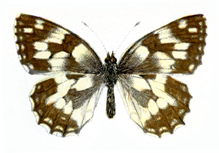
Melanargia (ex Agapetes) galathea Linnaeus, 1758 [Nymphalidae, Satyrinae]: a satyrine with a wingspan of 37–52 mm, distinguished from most others by its basically white wings "chequered" a dark brown. It is common on grassy, flowery and bushy places in NW Africa, W, C and SC Europe across Asia Minor to S. Urals and N Iran, but absent from large areas within its main region of distribution. "Extremely abundant in some places, such as hayfields in the Alps, where it flutters from flower to flower; up to about 1500 m. in Switzerland but to much greater altitudes when indulging in the half-hearted migratory flights which I have observed in the case of this species …"
*SelLet 287; NabBut 527 (L), 594–5 (BE); Lep1 32; Lep2 270
& Ac: Melanárgia/Agapétes galathéa • En: (Galatea) Marbled White • Fr: le demi-deuil • Ge: Schachbrett, Damenbrett, Brettspielfalter • It: melanargia, galatea • Ru: пестроглазка Галатея, (DarII) Галатея • Sp: medioluto norteña
Melanargia occitanica Esper, 1793, syn psyche Hübner, 1800 [Nymphalidae, Satyrinae]: the Western Marbled White, in SW Africa and SW Europe.
*NabBut 595 (BE)
Melanargia russiae Esper, 1783 [Nymphalidae, Satyrinae]: a Marbled White, in Italy, SW and SE Europe, Asia Minor, S Russia, Transcaucasia, W Siberia, C Asia, E Kazakhstan, Tianshan.
*NabBut 595 (BE)
& Ac: Melanárgia rússiae • En: Esper's Marbled White • Fr: l'échiquier de Russie, l'échiquier d'Esper • Ru: пестроглазка русская • Sp: medioluta montañera
Melanargia russiae russiae Esper, 1783, syn suwarovius Herbst 1796 [Nymphalidae, Satyrinae]: the nominal subspecies of Esper's Marbled White, described from S Russia.
*NabBut 207 (FB)
& Ru: (DarII) «суворовская» меланаргия
Meleager: »Polyommatus daphnis
Meleageria de Sagarra, 1925: an abandoned genus of »Lycaenidae, subfamily Polyommatinae (blues). The type-species was »Meleageria daphnis Denis & Schiffermüller, 1775. Due to Bálint & Johnson's reformation of the »Polyommatus Section in 1997, the genus was included in Polyommatus Latreille, 1804.
*SelLet 438; Lep9 48
Meleageria daphnis: »Polyommatus daphnis
melissa roei Doe: »(Plebejus) scudderi doei Roe
Melitaea Fabricius, 1807: a genus of »Nymphalidae, subfamily Nymphalinae, tribe Melitaeini (checkerspots). The type-species is »Melitaea cinxia Linnaeus, 1758, the Glanville Fritillary, in Morocco, W Algeria. Europe, Turkey, Lebanon, Russia, N Kazakhstan, Mongolia.
*NabBut 230 (FB), 524, 597 (BE), 623 (L); LtVé 89, 249
Melitaea anicia: »Euphydryas anicia
Melitaea athalia: »Mellicta athalia
Melitaea aurinia: »Euphydryas aurinia
Melitaea cinxia (Lampert 1907)
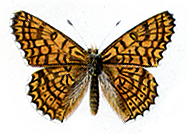
Melitaea cinxia (not xinxia) Linnaeus, 1758 [Nymphalidae]: the Glanville Fritillary, a common fritillary of medium size (wingspan 33–40 mm) in Morocco, W Algeria, Europe (except British Isles and N of Scandinavia), Russia, Turkey, Lebanon, Russia, N Kazakhstan, Mongolia.
According to Nabokov ("Butterflies of Europe", 1964), Melitaea cinxia pallidior Oberthür, 1909 is "hardly a true subspecies. Similar strains, due to accidental seasonal conditions, occur elsewhere." Yet it seems to be a valid subspecific name.
*NabBut 597 (BE); Lep1 31; Lep2 268
& Ac: Melitáea cínxia • En: Glanville Fritillary • Fr: le damier • Ge: Gemeiner Scheckenfalter • Ru: шашечница Цинксия • Sp: doncella del llantén
Melitaea deione: »Mellicta deione
Melitaea diamina Lang, 1789, hom dictynna Esper, 1779, var. vernetensis Rondou, 1902 [Nymphalidae]: a variety of the False Heath Fritillary, in N Spain, taxonomically without standing.
*Lep2 269
Melitaea dictynna var. vernetensis: »Melitaea diamina
Melitaea didyma: »Didymaeformia didyma
Melitaea parthenie: »Mellicta aurelia
Melitaea phoebe: »Cinclidia phoebe
Melitaea trivia: »Didymaeformia trivia
Mellicta Billberg, 1820: a genus of »Nymphalidae, subfamily Nymphalinae, tribe Melitaeini. The type-species is »Mellicta athalia, the Heath Fritillary.
Mellicta athalia (Lampert 1907)
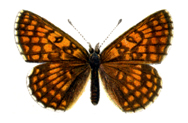
Mellicta athalia Rottemburg, 1775 [Nymphalidae]: a common small Fritillary (wingspan 25–38 mm) in much of Europe and across temperate Asia to Japan. This is the species most frequently represented in the Lausanne collection of Nabokov's European captures. Between 1961 and 1973, he took 192 specimens, all of them in the W Alps from Lake Garda through Switzerland to the Sea Alps in France.
"The task of naming and grouping the races of Athalia is pretty hopeless. The splitter has a field day and the lumper is balked by the fact that one finds small dark forms collected a few miles away from the type localities of large bright ones" ("The Butterflies of Europe", 1964).
*SelLet 484; NabBut 598 (BE); 623 (L); Lep1 31
& Ac: Mellícta athália • En: Heath Fritillary • Fr: la mélitée de la mélampyre • Ge: Gemeiner Scheckenfalter • It: atalia • Ru: шашечница Аталия • Sp: atalia, doncella común
Mellicta athalia var. helvetica Rühl, 1995 [Nymphalidae]: a variety of the Heath Fritillary (»Mellicta athalia), described from the canton Grisons, Switzerland, taxonomically without standing.
*NabBut 623 (L)
Mellicta aurelia (Lampert 1907)
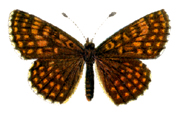
Mellicta aurelia Nickerl, 1850, hom parthenie Borkhausen, 1788 [Nymphalidae]: a fritillary of C and E Europe, Caucasus and C Asia. Nabokov confirms that "Böhmen" as the type locality is correct. Between 1962 and 1972, he captured 129 specimens in the cantons Valais, Grisons, in the Dolomites and on Lake Garda. The name parthenie for this butterfly was used twice within the same genus, in 1788 by Borkhausen for Mellicta aurelia and in 1819 by Godart for »Mellicta parthenoides; hence it is invalid.
The race mendrisiota Fruhstorfer, 1919 described from Monte San Giorgio in the canton Ticino was synonymized under aurelia and thus disappeared as a name.
*SelLet 484; NabBut 598 (BE), 623 (L)
& Ac: Mellícta aurélia • En: Nickerl's Fritillary • Fr: la mélitée de Nickerl • Ge: Ehrenpreisscheckenfalter • Ru: шашечница Аурелия
Mellicta britomartis Assmann, 1847 [Nymphalidae]: Assmann's Fritillary, in C Europe, C Asia, Transbaikal, Mongolia, NE China, Korea. The variant form melathalia Rocci, 1930, described from Lombardy along the Ticino River, has been synonymized under britomartis, so the name has disappeared.
*NabBut 598 (BE), 623 (L)
& Ac: Mellícta britomártis • En: Assmann's Fritillary • Fr: la mélitée d'Assmann • Ge: Östlicher Scheckenfalter • Ru: шашечница Ассмана
Mellicta (ex Melitaea) deione Geyer, 1832 [Nymphalidae]: the Provençal Fritillary, in N Morocco, W Algeria, Iberian Peninsula, SE France. Could be the subspecies Melitaea (i.e., Euphydryas) aurinia deione, according to Nabokov.
*Lep2 268, 269
Mellicta deione berisalii Rühl, 1891 [Nymphalidae]: a subspecies of the Provençal Fritillary, restricted to the Rhône Valley in the canton Valais, Switzerland, at elevations of 300–1,200 m.
*NabBut 698 (L)
Mellicta parthenoides Keferstein, 1851, hom parthenie Godart, 1819 [Nymphalidae]: the Meadow Fritillary, in W Europe. The variety beata Caradja, 1894, described from the Pyrenees, was synonymized under parthenoides and consequently abandoned.
Mellicta parthenoides sphines Fruhstorfer, 1916 is an invalid synonym of the nominal subspecies, Mellicta parthenoides parthenoides, described from Burgundy, France.
*NabBut 599 (BE), 623 (L), Lep2 269
Mellicta (ex Athaliaeformia) varia Meyer-Dür, 1851 [Nymphalidae]: the Grisons Fritillary, in the Alps and Apennines. "It differs from [»Mellicta] parthenoides in the same way as parthenie [»Mellicta aurelia] differs from [»Mellicta] britomartis, or [»Mellicta] deione from [»Mellicta] athalia, that is in the rudimentary state of the uncus."
"In August 1961 I found it occurring in small restricted colonies here and there on high slopes above the Simplon Pass. This I would fix at its type locality. Found also in Maritime Alps, Switzerland, Mts. of North and Central Italy, Austria and Tyrol".
*NabBut 599 (BE), 623 (L)
Melmoth: as Nabokov explained in a letter to Alfred Appel, Jr., the name "Melmoth may come from Melonella Moth (which breeds in beehives) or, more likely, from Meal Moth (which breeds in grain)". Several moths that breed in grain are called meal moths, escpecially Pyralis farinalis Linnaeus, 1758 [Pyralidae]. The Melonella Moth is Galleria mellonella Linnaeus, 1758 [Pyralidae].
*Lol 227, 416–417; SelLet 413
& Ac: Pýralis farinális • En: Meal Moth • Ge: Mehlzünsler • Ru: огневка мучная
& Ac: Galléria mellonélla • En: Honeycomb Moth • Ge: Große Wachsmotte • Ru: вощинница пчелиная • Sp: polilla de la cera
Metarranthis mollicularia Zeller, 1872 [Geometridae, Ennominae]: This Nearctic geometer moth probably is the one Professor »Forbes had dissected and returned to Nabokov at the MCZ in 1945.
*SelLet 55
micro: a microlepidopteron, a very small moth. The term Microlepidoptera frequently is used to distinguish very small moths from regular size butterflies and moths, called 'macrolepidoptera'. See in »Introduction.
*Gift 133
Micropterix aruncella (Photographer David Nicholls/ naturespot.org.uk)

Micropterix HÜBNER, 1825 [Micropterigidae]: a genus of Micropterigidae, with over 40 species. The Micropterigidae are the most primitive family of moths, with over 225 species worldwide. They are slender, with wingspans between 7 and 15 mm; the forewings mostly have a metallic bronze sheen. Their distinctive feature is that they have retained chewing mouthparts (mandibles) while all other lepidopterans have a proboscis. The type-species is Micropterix aruncella SCOPOLI, 1763. The spelling Micropteryx is an invalid synonym introduced by Zeller in 1839.
& En: Micropterigidae, Mandibulate Archaic Moths • Ge: Urmotten • Fr: les Microptérigidés • Ru: Первичные зубатые моли
*LtVé 249
Microzegris pyrothoe (Tuzov 1997)
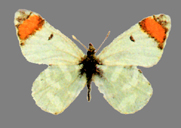
Microzegris (ex Zegris, Pontia) pyrothoe Eversmann, 1832 [Pieridae, Pierinae]: a white butterfly with orange forewing tips bordered by a string of dark beads; the hindwings are mottled white and gray. Its wingspan is about 30 mm, so it is markedly smaller than »Anthocharis cardamines, the Orange-tip of W Europe. Its range is from the plains of SE Russia to SW Siberia, Turan, Kazakhstan and W China. It is a spring butterfly, flying from March.
This is the little butterfly referred to twice in "Father's Butterflies": "… the orange wingtips, almost in keeping with fashion, of the African pierids, the neat and graceful pirotoi [not pirata, a misreading], the beauty of the spring steppes." It recurs on p. 207–8 as the "already mentioned delicate Steppe Aurora."
*StrOps 331; NabBut 206 (FB), 207-8 (FB)
& Ac: Microzégris pyróthoë • En: Eversmann's Orange-tip • Fr: *l'aurore d'Eversmann • Ge: *Eversmanns Zegris • Ru: зорька пламенная, (DarII) степная аврора
|
Euxia auxiliaris, the Miller Moth (Wikipedia) |
Ascalapha odorata, the Black Witch (Laithwaite 1975) |
|
|
|
miller, miller moth: There are "hundreds of powdered bugs wheeling around the lamps in the soggy black night" in Lolita (p. 162). The place are the grounds of the hotel The Enchanted Hunters, in NW Connecticut. To Alfred Appel, Jr., Nabokov explained what he had in mind: "... noctuids and other moths which look floury on the wing (hence 'millers,' which, however, may also come from the verb), as they mill in the electric light against the damp night's blackground" (Lolita, p. 381). Hence no particular taxon is implied.
In the narrow entomological sense, the Miller Moth is a particular geometrid moth, Euxoa auxiliaris GROTE, 1873, also called Army Cutworm, flying in the Prairie States and the W of the US. The caterpillars feed on wheat and oats and are feared as a pest by farmers but praised by bears who relish the fat of the worms. The moths come fluttering in swarms.
On p. 91 of Alice Ford's Audubon's Butterflies, Moths and other studies reviewed by Nabokov (Lep20), there is a black-and-white drawing with a caption calling the insect portrayed a 'Miller Moth'. Actually, the drawing (by Maria Martin, "one of Audubon's ablest helpers") shows a specimen of Ascalapha odorata Linnaeus, 1758 (ex Erebus odora), a blackish Neotropical noctuid (subfamily Catocalinae) with a wingspan of 130–140 mm making it the largest owlet moth in North America where it sometimes errs, occasionally as far north as Canada. The common name is 'Black Witch'. (There was a satanistic pop singer, Sophia, who called her debut album 'Erebus odora'.) The error Nabokov corrects when he writes "'Miller' should be 'Witch'" thus is not one of identification but of the common name chosen.
*Lol 126, 241, 381; StrOps 329; SelLet 413
|
Mimas tiliae and its caterpillar (Lampert 1907) |
|
|
|
|
*Mimas tiliae Linnaeus, 1758 [Sphingidae, Sphinginae]: in The Aurelian, Pilgram on a Berlin roadside shrub picks up a "large turquoise-green caterpillar with a china-blue horn on the last ring". Taking the horn on the last (!) ring as a lead, Zsolt »Bálint has identified the caterpillar as that of Mimas tiliae. This is a rather common Palearctic hawk moth with a wingspan of 55–70 mm, flying in Europe, Turkey, Russia and W Siberia. The green caterpillar is indeed large, about 65 mm, and lives mainly on lime trees. It is most appropriate that Pilgram should find this caterpillar where he does, for the Lime Hawk is common in urban parks and gardens, and linden trees are lining many Berlin streets.
*Stories:Aur 248
& Ac: Mímas tíliae • En: Lime Hawk • Fr: le sphinx du tilleul • Ge: Lindenschwärmer • Ru: бражник липовый • Sp: esfinge del tilo
Minois dryas (Lampert 1907)
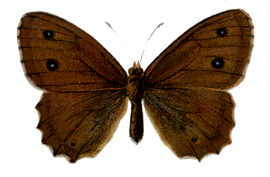
*Minois (ex Enodia, Satyrus) dryas Scopoli, 1763 [Nymphalidae, Satyrinae, Satyrini]: a satyrine with a wingspan of 45–60 mm. In flight it appears to be entirely black. However, in the females there are two blue eyespots on each of its forewings. It used to fly in temperate Eurasia from SW Europe to Japan, up to 1,500 metres, on open and woodland meadows; in Europe, it is on the decline.
*Glory 86; Lep1 32
& Ac: Mínois drýas • En: Dryad • Fr: le grand nègre des bois • Ge: Blauäugiger Waldportier • It: driade • Ru: сатир Дриада, бархатница дриада • Sp: ojos azules
Mitoura hesseli Rawson & Ziegler, 1950 [Lycaenidae, Theclinae]: Hessel's Hairstreak (or White Cedar Hairstreak), a rare N American hairstreak with a wingspan of c. 24 mm, brown above, green below. Its habitat is white-cedar swamps along the Atlantic coast, from New Hampshire to North Carolina and along the Gulf coast of Florida. The species was described from Lakehurst, New Jersey, in 1950.
*SelLet 327
Mitoura johnsoni Skinner, 1904 [Lycaenidae, Theclinae]: Johnson's Hairstreak, locally from S British Columbia to C California.
*Lep16
Mitoura siva W.H. Edwards, 1874 [Lycaenidae, Theclinae]: the Siva Hairstreak, in the Rocky Mountains, from SW North Dakota to New Mexico and NE Arizona, and in S California.
On May 31, 1959 Nabokov wrote entomologist John »Franclemont that he had found "a rather wonderful, apparently undescribed, green hairstreak close to M. siva" in the Big Bend National Park, Texas. There is a very similar small green hairstreak, Xamia xami Reakirt, 1866 in Mexico north of Veracruz and Mexico City, reaching the Mexican border region of Texas and Arizona. Perhaps that was the uncommon butterfly resembling the Siva Hairstreak that Nabokov observed in Big Bend National Park on the Rio Grande.
*NabBut 528 (L)
Mitoura spinetorum Hewitson, 1867 [Lycaenidae, Theclinae]: the Thicket Hairstreak, west of the Rocky mountains from S British Columbia to N Baja California and Jalisco.
*NabBut 618 (L), Lep16
mollicularia: »Metarranthis molliculari
Monarch: »Danaus plexippus
Morphinae Kirby, 1879: a small subfamily of »Nymphalidae, comprising the c. 80 species of the genus »Morpho. Many authors, following Kirby, treat the morpho butterflies as a family (Morphidae), some merely as a subfamily of sorts.
& Ac: Morphínae • En: Morpho Butterflies • Fr: morphidés • Ge: Morphofalter • It: mòrfidi, morfi • Ru: морфиды • Sp: morfos
Morpho menelaus (© DEZ 2001)
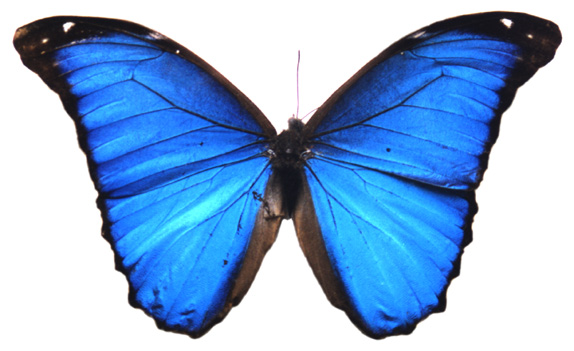
Morpho Fabricius, 1807: a genus in a subfamily of »Nymphalidae, the »Morphinae. It comprises some eighty large to very large tropical butterflies, occurring only in S and C America, especially in the Amazonas basin. In some of its species (often only the males), the upperside of the wings is of a striking and deep unicolored metallic blue, the famous Morpho lustre ("a harsh sheen") which is so incredible that old illustrators who colored the drawings usually rendered it too dark and dull; later, printers sometimes added a film of silver which missed the point as well, and even modern photography cannot quite cope with the metallic blue as it blazes in the tropical sun. The colors are so-called structural ones, made without pigments, only by the refraction of the scales, and hence permanent. They serve a purpose: when flying high above or among the treetops of the rain forest as Morphos usually do, their bright reflections blind birds that may want to attack them. The undersides usually are of a dull brown with eyespots, so as soon as the Morpho settles down it becomes quite inconspicuous and seems to disappear. For use in Brazilian handicrafts (plates, trays, night-blue pictures), some of these butterflies which are swift flyers and difficult to catch are raised in Morpho farms. Formerly they used to be caught by convicts. Feltwell: "About six million specimens are taken annually, but this does not appear to have affected population levels." The species most commonly used for butterfly handicrafts is the Brazilian Morpho (Morpho aega Hübner, 1822), with a wingspan of 80–90 mm.
"… if I use 'morpho blue' I am thinking not of one of the many species of variously blue Morpho butterflies of South America, but of the ornaments made of bits of the showy wings of the commoner species" (Nabokov in a letter to Alfred Appel, Jr., April 3, 1967 – SelLet 411).
The phrase "broken like Morphos" in Pnin (p. 92) probably refers to their commercial dismemberment.
The information supplied in Look at the Harlequins! (p. 67) does not quite suffice to identify the four Morphos on display. The two big ones might be the Blue Morpho (Morpho menelaus Linnaeus, 1758) and Cramer's Blue Morpho (Morpho rhetenor Cramer, 1775), both with a wingspan of c. 140 mm, the less metallic looking one with white lines The Morpho (Morpho cypris Westwood, 1847), wingspan c. 105 mm, the one gleaming "like silvery satin" the Mother-of-Pearl Morpho (Morpho laertes Drury, 1770, wingspan c. 100 mm.
In Look at the Harlequins! (p. 156), there also is "a sedate Bellargus sedan of a celestial blue that Bel was to compare with that of a Morpho". Indeed, the celestial blue of the Adonis Blue (»Polyommatus bellargus) is a structural color, as is that of the Morphos. When Nabokov gave butterfly names to cars ('Icarus,' 'Argus,' 'Bellargus'), it very probably was as a hint to their color. Since Nabokov's death, automobile manufacturers have actually produced car paints that imitate the structural colors of butterflies.
*Stor:Aur 244, 250; BendSin 227; Pnin 92; Ada 551; LHarl 67, 156; SelLet 410–411, 468, 562
Morpho sylvia: "the Sylvia Morpho", an imaginary rather unpretentious morpho Nabokov drew in 1947 for his Wellesley College colleague, the short-story writer Sylvia Berkman, in a copy of Nine Stories.
*NabBut plate 15
Morpho verae: "Véra's Morpho," an imaginary blue morpho Nabokov drew for his wife on her birthday, January 5, 1955, on the title page of a copy of Drugie berega. It has the remark, "very, very rare". On the opposing page there is the drawing of an unnamed tailed (kite?) swallowtail.
*Véra's Butterflies, p. 148
moth: any lepidopteron belonging to the Heterocera (i.e., 'those with differently shaped antennae', many – but by no means all of them – flying by night or at dusk). Heterocera, or moths, are one of the two basic groups of Lepidoptera (»Introduction).
Humbert Humbert, being no entomologist, cannot even tell a moth from a butterfly (Lolita, p. 110).
The "ample dark moth with hoary margins" of Glory (p. 158) might be »Saturnia pyri.
If Karges (1985) really thinks the large moth circling a station lantern on the way to Biarritz, France (Glory, p. 21) might be »Iphiclides podalirius, the Scarce Swallowtail, she would be far off the mark, indeed; the insect Martin catches a fleeting glimpse of is a night-flying moth, not a stately papilionid. There is no way this moth could be identified; it might be any of thousands.
The same goes true for the "fat-bodied, fluffy moth with glowing eyes" of The Defense (p. 66). As the »Noctuidae (owlet moths) are known for their glowing eyes, it probably is one of them.
The "large, banded moths, silently diving and hurrying toward the bait" (The Gift, p. 109) could not be identified if it were not for the French translation supervised by Nabokov. There they are rendered by "grandes lichénées fasciées" which makes them noctuids, probably of the genus »Catocala Schrank, 1802.
The "remarkable semi-aquatic moth with a rudimentary system of veins" the hero of The Gift (p. 124) imagines he discovers may be a member of the large family of Pyralidae. In Europe, there is Elophila nymphaeata Linnaeus, 1758, with a wingspan of 22–30 mm, living near ponds and lakes and skimming the water surface at dusk. The caterpillars live on water lilies, the pupae under water.
The "small downy moth with marbled forewings" of Invitation to a Beheading (p. 169) probably is a noctuid.
The moth in Invitation to a Beheading (p. 203) which so scares Cincinnatus' jailer is amply described; in all likelihood it is the Peacock Moth, »Saturnia pyri.
In a letter to the critic Richard Schickel, written on Jan 1, 1958 (Selected Lettters, p. 239), Nabokov wrote, "I annually attempt to identify the noctuid moth that circles around a lamp in the brothel scene of Joyce's 'Ulysses'." The corresponding passage is not in Lectures on Literature, so that attempt at idenfication is lost.
The last sentence of Bend Sinister ("A good night for mothing") means: a good night for catching moths. They are caught by luring them towards a strong light or a sweet mixture of something. One of Nabokov's early poems (in Grozd', 1923, translated in NabBut 105–107) is a long, heart-rending and technically precise evocation of his moth collecting in the parks and gardens of Vyra:
… from another land
I look into the depth of a melancholy garden;
I remember evenings at the start of fall,
and my oak on the meadow, and the honey smell,
and I cry, and I fly, and in the twilight with you
I soar and breathe beneath the gentle foliage.
In a letter to Edmund Wilson (August 9, 1942), he called luring moths "the noblest sport in the world". (See also under »Smerinthus ocellatus, »Nabokov on butterflies: How to catch moths.)
According to Appel's Annotated Lolita (p. 381), Nabokov identified the "powdered bugs" of Lolita (p. 126) as "noctuids and other moths which look floury on the wing (hence '»millers')."
According to Dmitri Nabokov ("On Revisiting Father's Room", p. 127), his father used "an American dictionary with the national eagle on its olive-brown cover transformed into a magnificent furry hawk moth". The dictionary was the American Heritage Dictionary. Which hawk moth Nabokov drew is not known.
Translators should beware. The English word "moth" might mislead translators into any of the Germanic languages that have the same morpheme, but with a different meaning. Danish 'møl,' Dutch 'mot,' German 'Motte' all basically mean a member of the family Tineidae, counting around 2,000 species world-wide. They are those small and inconspicuous night-flying insects that before the advent of man typically lived in birds' nests and prefer to feed on hair, tissue, leather, feathers, seeds and mushrooms. The tiny reddish yellow one feeding on household textiles, especially wool, all over the world the way they have fed on the astrakhan collar of Despair (p. 135) is the clothes moth Tineola bisselliella Hummel, 1823, by far the best known and most unpopular of all Tineids, the German 'Kleidermotte' or simply 'Motte'. Insects the layman cannot distinguish from it may be referred to as 'Motten' in German. Though the German 'Motte' may be used for all moths idiomatically (as in the Marlene Dietrich song line "Männer umschwirrn mich wie Motten das Licht", "men are whirring around me like moths do around light"), the meaning 'clothes moth' is much too predominant to translate 'moth' by 'Motte'. The regular translation would have to be 'Nachtfalter'. I must have squashed dozens of wrong 'Motten' when revising Nabokov translations (including my own early ones). The Swedish 'mott' refers to the large family Pyralidae. For each language, translators should make sure how to translate 'moth'.
*Stor:Xmas 133, Stor:1stLove 603; Defense 66; LaughD 116, 146, 206; Glory 21, 158; Despair 135; InvBeh 119, 169, 203–204; Gift 95, 103, 109, 110, 118, 123, 124, 137; Stor:SprFialta 423–424; Stor:CloudCL 430; BendSin 240; Lol 110; PaleF 172; Ada 59, 250, 376; StrOps 306; (N/W Let #45=38old), #142=113old, #231=191old; SelLet 239, 410; NabBut 105–107
& Ac: Heterócera • En: moths • Fr: papillons nocturnes, papillons de nuit • Danish: natsommerfugl • Dutch: nachtvlinder • Ge: Nachtfalter, Phalaenae • It: falene • Ru: мотыльки, ночницы • Sp: mariposas nocturnas, falenas • Swedish: nattfjäril
& Ac: Pyrálidae • En: Pyral(id) • Ge: Zünsler • Ru: настоящие огневки
& Ac: Tinéola bisselliélla • En: Common Clothes Moth • Fr: la mite, la teigne • Ge: (Kleider-)Motte • It: tarma • Ru: моль платяная • Sp: polilla
Mountain Fritillary: »Boloria napaea
Mulberry Moth: »Bombyx mori
Muschampia proto OCHSENHEIMER, 1808: the Large Grizzled Skipper (Sp: Polvillo dorado), from NW Africa and Portugal across S Europe to Asia Minor and the Middle East.
Nabokovia Hemming, 1960 [Lycaenidae]: a generic name introduced by Francis »Hemming as a substitute for a homonym Nabokov had inadvertently used. See under »Pseudothecla (in Section 1.2.1). Together with Echinargus, the genus Nabokovia makes up the Nabokovia Section in the tribe Polyommatini, subfamily Polyommatinae.
Nabokovia faga (Peña Guzmán 1996)
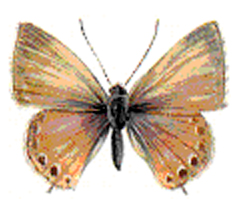
Nabokovia faga Dognin, 1895 [Lycaenidae]: the Beech Hairstreak, Spanish Licena faga, a blue in Ecuador and Peru, the type-species of the genus Nabokovia Hemming, 1960 (cf. »Section 1.1).
*SelLet 55; Lep9 11, 14
Nabokov's Blue: there are two polyommatines that have been called Nabokov's Blue (see in »Section 1.4). The one referred to in Strong Opinions is Nabokov's Blue1, »Plebejus idas sublivens Nabokov, 1949.
*StrOps 315
Nabokov's Pug: »Eupithecia nabokovi
Nabokov's Satyr: »Cyllopsis pyracmon nabakovi
Nabokov's Wood Nymph: »Cyllopsis pertepida dorothea
*SelLet 114, 239; NabBut 521 (L), 523 (L); Lep5
Nathalis iole Boisduval, 1836 [Pieridae, Coliadinae]: the Dainty Sulphur, a butterfly of tropical America, in the United States from Florida and S California to Minnesota and North Dakota.
*StrOps 328
Nemeobius lucina: »Hamearis lucina
Neognopharmia (ex Gnophos) stevenaria Boisduval, 1840 [Geometridae, Ennominae]: a geometer moth in S Europe.
*Lep1 33
Neohipparchia fatua Freyer, 1844 [Nymphalidae, Satyrinae, Satyrini]: Freyer's Grayling, in S Balkans, Turkey, Near East, Transcaucasia. It resembles the Striped Grayling (»Pseudotergumia fidia).
*NabBut 589 (BE)
Neohipparchia (ex Hipparchia, Satyrus) statilinus Hufnagel, 1766 [Nymphalidae, Satyrinae, Satyrini]: the Tree Grayling, in NW Africa. S and C Europe, Asia Minor, Caucasus, Transcaucasia. It is chocolate brown with two black eyespots on the forewings; the females are a lighter brown. The wingspan is c. 50 mm. The nominal subspecies Neohipparchia statilinus statilinus was described from the vicinity of Berlin. In most of Germany it is extinct.
The alleged subspecies fidaeoformis Verity, 1911 has been synonymized under statilinus and thus has disappeared as a name.
*NabBut 588 (BE); Lep1 32
& Ac: Neohippárchia statilínus • En: Tree Grayling • Fr: le faune • Ge: Eisenfarbiger Samtfalter • Sp: satiro moreno
Neohipparchia statilinus australis Zeller, 1847 [Nymphalidae, Satyrinae, Satyrini]: a subspecies of the Tree Grayling, described from Rome.
"I am inclined to lump under this name all the large strains of statilinus (formerly known as 'fatua Freyer') such as fidiaeoformis Verity [1919] … and onosandrus Fruhstorfer [1908, from S Tyrol, Brescia, Torino] … When one sees for the first time this large fidia-like butterfly (for instance in the environs of Mentone where it flies with [»Pseudotergumia] fidia one does tend to mistake it for a distinct species from typical statilinus." Like fidaeoformis, the subspecific name onosandrus was synonymized under statilinus and thus has disappeared.
*NabBut 589 (BE)
Neominois Scudder, 1875: a genus of »Nymphalidae, subfamily Satyrinae, tribe Satyrini (US true satyrs, GB graylings). The type species is »Neominois ridingsii, the Grasshopper Satyr.
*NabBut 495 (L)
Neominois ridingsii W.H. Edwards, 1865 [Nymphalidae, Satyrinae]: the Grasshopper Satyr, from the foothills of the Rocky Mountains in Colorado and New Mexico to California, preferring sagebrush grassland.
*StrOps 326
Neonympha areolata (ventral)

Neonympha Hübner, 1818: a genus of »Nymphalidae, subfamily Satyrinae, tribe Euptychiini (US wood satyrs). The type-species is Neonympha areolata J.E. Smith 1797, the Georgia Satyr. The members of the genus Nabokov worked on have since been transferred to the genus »Cyllopsis R. Felder, 1869.
*NabBut 248 (L), 249 (L), 498 (L); Lep5; Lep6
Neonympha dorothea n.sp. [Nymphalidae, Satyrinae]: see »Cyllopsis pertepida dorothea. "Pleasingly called by lepidopterologists 'Nabokov's Wood Nymph'."
*SelLet 239
Neonympha maniola n.sp. [Nymphalidae, Satyrinae]: see »Cyllopsis pertepida maniola.
*Lep5; Lep6
Neptis Fabricius, 1807: a genus of »Nymphalidae, subfamily Limenitidinae (admirals). "Languidly gliding, rather eerie, butterflies of glades and groves, where they sail through sunbeams and settle on shrubs." The type-species is Neptis sappho Pallas, 1771, the Common Glider, in E Europe, S Russia, temperate Asia and Japan. The type locality was Volga, S Russia.
*NabBut 602 (BE)
& Ac: Néptis sáppho • En: Common Glider • Fr: le sylvain de la gesse • Ge: Schwarzbrauner Trauerfalter • Ru: пеструшка темнокрилая
Neptis (ex Limenitis) rivularis Scopoli, 1763 [Nymphalidae]: the Hungarian Glider, in the S European Alps, E Europe, Turkey, Caucasus, C Asia, S Siberia, Mongolia, N China, Korea, Japan, Taiwan.
*Lep2 269
Nettlefly: »Aglais urticae
Nevada Grayling: »Pseudochazara hippolyte
Niobe (Fritillary): »Fabriciana niobe
Nisoniades tages: »Erynnis tages
n
itra Swallowtail: »Papilio zelicaon nitra
noctuid moth, noctuid: a moth of the family »Noctuidae (owlet moths).
*SelLet 239; Lep2 257
Noctuidae Stephens, 1829 (ex Phalaenidae): the robust moths of the largest family of the Lepidoptera, comprising hundreds of genera and more than 25,000 species, most of them flying by night. They range all over the world. Morphologically theirs is a rather homogenous taxon, but they differ greatly in size, with wingspans between 5 and 100 mm. The color is mostly a grayish brown. The forewings are narrower and longer than the hindwings which lack markings. By night they have glowing eyes. At rest the shape is delta-like.
& Ac: Noctúidae • En: noctuids, owlet moths, deltoid moths • Fr: noctuidés, noctuelles • Ge: Noctuiden, Eulen(falter) • It: nottuidi • Ru: совки • Sp: noctuidos
Nogel's Hairstreak: »Tomares nogelii
Nomiades cyllarus aeruginosa: »Glaucopsyche alexis aeruginosa
Nomiades semiargus: »Polyommatus semiargus
Norfolk Swallowtail, Norfolk race of the Swallowtail: »Papilio machaon britannicus
Northern Wall Brown: »Lasiommata petropolitana
Notodontidae Stephens, 1829: a cosmopolitan family of moths closely related to the »Noctuidae, comprising around 2,500 species, most of them in S America. They have narrow forewings and are of a somber color. Their habitat are deciduous woodlands, and they are night-flying. Their name derives from Greek notos, 'back', and odontes, 'teeth'. They owe it to a crest of sclerotized hard scales on the head and the thorax which protrude toothlike.
& Ac: Notodóntidae • En: notodontids, prominent moths • Fr: notodontidés, notodontes, queues-fourchues • Ge: Notodontiden, Zahnspinner • It: notodonti • Ru: хохлатки • Sp: notodóntidos
nymph: The entomological overtones of the word 'nymphet' as used by Nabokov have not always been appreciated correctly.
The word is classical Greek and literally means 'maiden' or 'bride'. A nymph in Greek mythology, according to Webster III, was a minor divinity of nature – that is, a demon – represented as a beautiful maiden. For instance, there were thought to be wood nymphs (dryads) inhabiting the forests and naiads inhabiting sources and brooks. The American members of the genus Cercyonis Scudder, 1875 [Nymphalidae, Satyrinae] are called 'wood-nymphs'. The generic name of the North American »ringlets, Coenonympha Hübner, 1819, means 'common nymph'.
To understand why Lolita's "nature is not human but nymphic," one must briefly review the life cycle of insects.
They all pass through up to four distinct successive stages called instars. These are egg, caterpillar (or larva), pupa and imago (or adult). Some, including Lepidoptera, undergo complete metamorphosis, passing through all four instars. They are called holometabolic.
The female deposits fertilized eggs – the insect's embryos. After a few days, in some species after the winter is over, there emerges a larva which in the case of butterflies and moths is a caterpillar. Its main raison d'être is to acquire biomass, that is, to eat and grow. The larval or caterpillar stage lasts from two weeks to nine months, in some cases up to seven years. When their skins get too tight, they shed it and grow a bigger one; there usually are around four or five molts.
When the larva has acquired enough biomass, it turns into a pupa which in diurnal butterflies is also called a chrysalis because of the metallic golden sheen on many of them. Chrysalises are more or less immobile and somewhat protected by a hard shell. In their interior, the insect breaks down or transforms many of its caterpillar features and develops into the adult form that will fly. This pupal stage lasts from ten days to several years.
The main purpose in the life of the adult which finally emerges from the pupal cocoon is to find a mate and to reproduce. The life of the imago lasts from a few hours up to ten months in the species that hibernate in this instar. The reason for these transformations, generally speaking, is to give the insect the form that best suits the tasks and the season ahead of it. Only rarely do they spend the cold season in the imaginal form – most winter either as eggs, caterpillars or pupae.
Once Nabokov remarked that one of the layman's foolish questions about butterflies was whether they grow (N/WLet 69=58old). The answer of course is, no. They do all their growing as caterpillars. The imago doesn't grow, it just unfolds as soon as it has broken its cocoon.
Other insects – called hemimetabolic for that reason – undergo one stage less. They skip the pupal stage, turning from larvae directly into adults.
Now the word 'nymph' is used somewhat loosely in entomology, with subtle shades of meaning between different languages. The misunderstanding has arisen from the fact that Webster III has the following – incomplete and therefore misleading – definition: "any of various hemimetabolic insects in an immature stage … broadly: any insect larva that differs chiefly in size and differentiation from the imago". Thus it would seem that the word in the narrower sense does not apply to butterflies and moths at all and that in a broader sense it refers mainly to a caterpillar. This must be the reason why Karges (1985) argued (p. 45) that "as a metaphor of youth, it [the word nymph] has no reference to Lepidoptera" and was used by Nabokov out of "disingenuousness". Likewise, Lionel Trilling's assumption that a nymph is the "young of an insect without complete metamorphosis" may be traced to this source.
Diana Butler (1960) is still further off the mark when she argues that "Humbert's distinctions between nymphets and non-nymphets echo the distinctions between moths and butterflies … moths are big-bodied and butterflies are slender-bodied …" The distinction between butterflies and moths is not a too clear-cut one, but certainly body size is not a useful criterion at all, there being plenty of slim moths and plump butterflies. And of course, in entomology there are no nymphets alongside the nymphs.
To straighten things out, it must be noted that the word 'nymph' is used for holometabolic insects like Lepidoptera as well. The complete edition of the OED explains what Webster does not: "nymph 3.a.: An insect in that stage of development which intervenes between the larva and the imago; a pupa". In French, nymphe is the regular word for 'pupa'; se nymphoser means 'to pupate'. Hence, in butterflies and moths 'nymph' is just another word for 'pupa' or 'chrysalis'.
In Russian, 'nimfa' seems to be restricted to hemimetabolic insects. This is how the Great Soviet Encyclopedia defines it: "The n. resembles the adult form [in hemimetabolic arthropods] but has underdeveloped sexual apparatus and, in winged insects, underdeveloped wings. After molting many times the nymph becomes an imago, a fully mature individual." Thus the Russian use of the word stresses the fact that nymphs are sexually immature hemimetabolic insects. (In Russian nimfa is also the common name for all »Nymphalidae.)
In German entomology, 'Nymphe' is used for both hemimetabolic and holometabolic insects. The word designates the last pre-imaginal state (whether of the larva or the pupa) which already shows the outlines of the wings the adult will possess. Of this very stage, Nabokov said: "… in certain species, the wings of the pupated butterfly begin to show in exquisite miniature through the wing-cases of the chrysalis a few days before
The pupa of the Monarch butterfly (Danaus plexippus) shortly before eclosion (Smart 1976)
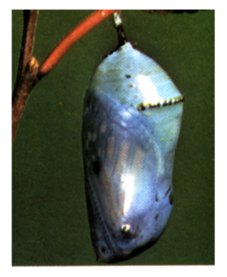
emergence. It is the pathetic sight of an iridiscent future transpiring through the shell of the past, something of the kind I experience when dipping into my books written in the twenties" (Int18 123).
With all of these meanings, if Lolita is a little nymph, she is a young individual on the very verge of turning into an adult, already showing the adult's wings, but not yet sexually mature. Calling Lolita a nymphet was not being disingenuous at all. It is a very apt metaphor.
By the way, Latin pupa means 'girl' or 'doll'. Dolly is a nymph, and the nymphet is a doll.
*Gift 335; Lol 16; Ada 13
Nymphalidae Swainson, 1827: a family of butterflies, counting some 6,000 species with the newly included taxa, about one third of the entire butterfly fauna. Most of them fly in the tropics. To many people they seem to express the very idea of a butterfly. They are medium to large (25–130 mm), strong flyers and diversely and colorfully patterned, often on a basis of brown. On the tips of their antennae there are large prominent knobs. In males as in females, the forelegs are shortened to brushes and useless for walking, earning them the American group name brushfoots.
The subdivision of Nymphalidae has been subject to much contention. Currently there seem to be twelve subfamilies world-wide, though no two authors will agree about the exact number. Nine of them are present in Europe and N America: Apaturinae (emperors), Charaxinae (goatweeds), Danainae (milkweeds), Heliconiinae (longwings), Libytheinae (snouts), Limenitidinae (admirals), Nymphalinae (tortoiseshells, anglewings, checkerspots) and Satyrinae (browns, satyrs, ringlets, arguses, etc.). Until the advent of modern higher classification, some of these subfamilies were considered to form families of their own: Satyridae, Heliconiidae, Libytheidae and Danaidae. The Melitaeinae (checkerspots) have been made a tribe (Melitaeini) of Nymphalinae. Some authors have suggested that the S American Morphidae (morphos) and Brassolidae (owls) be made two tribes (Morphini and Brassolini) within the subfamily Morphinae. The Holarctic subfamily Argynninae (fritillaries) turned out to be a tribe of Heliconiinae (longwings), Argynnini – surprisingly, as the longwings were always believed to be more or less restricted to S and C America. The evidence for the move is based on the presence of lateral scoli (projections of the body wall) between the first three thoraic segments of the caterpillar.
A good deal of classificatory uncertainty persists, escpecially concerning Limenitidinae.
*SpeakM 133; NabBut 575 (BE)
& Ac: Nymphalidae • Am: brushfoots • En: nymphalids (admirals, anglewings, checkerspots, crescentspots, fritillaries, leafwings, longwings, painted ladies, tortoiseshells, e.a.) • Fr: nymphalidés (mars, sylvains, vanesses, nacrés, damiers …) • Ge: Nymphaliden, Fleckenfalter, Edelfalter (Admirale, Eckenfalter, Füchse, Landkärtchen, Perlmutterfalter, Scheckenfalter, Schillerfalter, Zackenfalter e.a.) • It: ninfalidi • Ru: нимфы (переливницы, настоящие нимфы, шашечницы, перламутровки) • Sp: ninfálidos
nymphalid: anyl member of the family »Nymphalidae
Nymphalis Kluk, 1802: a genus of »Nymphalidae, subfamily Nymphalinae, tribe Nymphalini. The type-species is »Nymphalis polychloros Linnaeus, 1758.
*StrOps 326
Nymphalis antiopa (Lampert 1907)
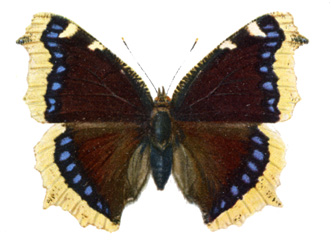
Nymphalis (ex Vanessa) antiopa Linnaeus, 1758 [Nymphalidae]: one of the beautiful and distinctive butterflies of the northern hemisphere. In Europe it can be found up to the northernmost tip of Norway. Its wingspan is 56–80 mm. On the upperside the wings are maroon with a ragged yellow margin, bordered inwardly by bright azure spots. The underside is purposefully drab so it can merge with dark bark when the butterfly is resting. When disturbed, it will start off very briskly, producing a clicking sound. The English name derives from the village of Camberwell near which the first specimen was taken in the 18th century.
"Throughout the Palearctic, except England and the Mediterranean islands, especially abundant in the birchwoods of the North; much less so among the willows of southern streams. Ranges southward to N. Africa and eastward to N. India and Japan. Widely distributed but not particularly common in the Nearctic … 'Rarity' among butterflies works in inverse ratio to size, and if antiopa were not bigger than a blue it would be considered rare in Switzerland or S. France" ("Butterflies of Europe", 1964).
On a postcard picturing this butterfly, Nabokov wrote to his sister Elena (September 1970):
We are distinguished by wings of black hue,
wine-iridescence, and granules of blue
following yellowish, crenulate borders.
Copses of birch are our favorite quarters.
(Translation by Dmitri Nabokov)
In the early twenties, Nabokov addressed one of his poems of exile to this butterfly ("Babochka" [The Butterfly] in Gorniy put'):
Velvety black, with the warm glow of a ripe plum,
here it opened wide; through this live velvet
delightfully gleams a row of cornflower-azure grains,
along a circular fringe, yellow as the rippling rye.
It has perched on a trunk, and its jagged tender wings breathe,
now pressing themselves to bark, now turning toward the rays …
Oh, how they exult, how divinely they shimmer! One would say:
a blue-eyed night is framed by two pale-yellow dawns.
Greetings, oh greetings, reverie of a northern birch grove!
Thrill, laughter, and love of my eternal youth.
Yes, I'll recognize you in a Seraph at the wondrous meeting,
I'll recognize your wings, their sacrosanct design.
(Translation from the Russian by Gavriel Shapiro and Dmitri Nabokov)
*Stikhi 60; Stor:Xmas 135; Mary 60; SebKn 137; SpeakM 231, 239; Ada 170; SelLet 473; NabBut 206 (FB), 398 (L), 495 (L), 596 (BE); Lep2 256, 268; Lep16; LtVé 193
& Ac: Nymphális/Vanéssa antíopa • Am: Mourning Cloak • En: Camberwell Beauty, Grand Surprise • Fr: le morio • Ge: Trauermantel • It: antiopa • Ru: нимфа Антиопа, (DarII) траурница • Sp: antiopa
Nymphalis californica Boisduval, 1852 [Nymphalidae]: the Western Tortoiseshell, from British Columbia along the West Coast to S California and eastward to the Rocky Mountains.
*StrOps 326–327
Nymphalis carmen: the Carmen Tortoiseshell, as it is called on the preceding page of Ada, is a "very local" invented nymphalid of the real genus Nymphalis Kluk, 1802 with "lemon and amber-brown wings" and thus perhaps somewhat similar to »Nymphalis antiopa. In the French Ada, this is "la Tortue Carmen".
*Ada 56
Nymphalis danaus Nab.: one of the invented butterflies of Ada, a "vanessian," "fantastically rare", "newly described" by Professor Nabonidus of Babylon College, Nebraska, mimicking "the Monarch through the Viceroy". The Viceroy is the American nymphalid, »Basilarchia archippus, while the Monarch which it mimics, »Danaus plexippus, is a cosmopolitan American of the danaine subfamily. The genus of the invented insect, Nymphalis Kluk, 1802, makes it clear that it belongs to one of the more showy members of the nymphalid family, while the species' name, danaus, is taken from the generic name of some of the best known danaines. The invented butterfly mimics the Viceroy which really mimics the Monarch. Its feat is based on hearsay, so to speak. The Viceroy is one of the most famous cases of Batesian mimicry in butterflies. It mimics the Monarch because this one has a reputation among predating birds as being highly distasteful, containing poisonous cardiac glycosides that in small dose will make birds vomit violently and in double dose will make them die of heart failure; they will remember after one try. The poison comes from their caterpillars' foodplant, the milkweed family. The protection to the Viceroy works only as long as there are Monarchs around to make the birds who try them sick. If the Monarch is not present where Viceroy and "Nymphalis danaus Nab." occur, mimicking the distasteful insect would be of no use. The predators would find only tasty Monarch-like butterflies and not learn to spare them. So by Darwinian standards, this imitation seemed impossible when Ada was written. Only later it turned out that the Viceroy is as distasteful as the Monarch (cf. »Nabokov and Mimicry).
*Ada 158
Nymphalis polychloros (Lampert 1907)
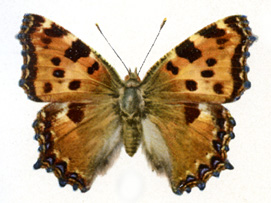
Nymphalis (ex Eugonia, Vanessa) polychloros Linnaeus, 1758 [Nymphalidae]: a pretty Palearctic nymphalid of temperate Eurasia and N Africa, absent in N Europe. It is reddish brown, with bold black, yellow and/or white marks and blue crescents along the borders of fore- and hindwings. The wingspan is 50 to 55 mm. Either this or »Aglais urticae, the Small Tortoiseshell (which is similar in appearance, but smaller) must be the butterfly in Cincinnatus' cell that a spider has partly eaten.
*Possibly InvBeh 119; SpeakM 128; possibly Ada 436–437; NabBut 603 (BE); Lep1 31; Lep2 255
& Ac: Nymphális/Eugónia/Vanéssa polychlóros • En: Large Tortoiseshell • Fr: la grande tortue • Ge: Großer Fuchs • It: vanessa multicolore • Ru: нимфа многоцветная, многоцветница • Sp: olmera, mariposa de los olmos
Nymphalis vau-album Denis & Schiffermüller, 1775, syn l-album Esper, 1781 [Nymphalidae]: a Holarctic tortoiseshell, in E Europe, Turkey, temperate Asia, NE China, Korea, Japan, Alaska, S Canada, N United States, Labrador. Nymphalis vau-album is similar to the pretty Large Tortoiseshell (»Nymphalis polychloros). The wingspan is 64–73 mm, the ragged wings are a rich rust-brown at the base blending into yellow crescents near the margins. There is a small silver 'l' or 'v' or comma mark on the lower hindwings. The 'vau' stands for the German letter 'v,' so the name means "white v".
*NabBut 398 (L), 495 (L)
& Ac: Nymphális vau-álbum • Am: Compton Tortoiseshell • En: False Comma • Fr: la vanesse du peuplier, la vanesse à V-blanc • Ge: Weißes L • Ru: нимфа эль-белое, многоцветница L-белое
Nymphalis vau-album j-album Boisduval & LeConte, 1833 [Nymphalidae]: a N American subspecies of the Compton Tortoiseshell, from Canada and the Midwest to Colorado and North Carolina. It has a 'j' mark below.
*StrOps 326
& Ac: Nymphális j-álbum • Am: Compton Tortoiseshell, Comma Tortoiseshell
Nymphalis (ex Eugonia, Vanessa) xanthomelas Esper, 1781 [Nymphalidae]: a tortoiseshell very similar to the Large Tortoiseshell (»Nymphalis polychloros) but a brighter orange. In E Europe, Turkey, C Asia, China, Korea, Japan. "Strays N. to the Gulf of Finland." In C Europe it has been on the decline since the 1920s and is almost extinct; farther E it continues through the woodland belt of temperate Asia to Korea and Japan.
A Yellow-legged Tortoiseshell was among Nabokov's Crimean captures. On July 2, 1918, he caught one male. As there never were any further captures recorded in the Crimea, it was believed Nabokov had misidentified his specimen. Consequently, xanthomelas was omitted from a catalogue of Crimean butterflies in 1985. However, on July 1, 1988, lepidopterist Professor Efetov, Simferopol, actually captured another specimen and reinstated it in his own catalogue [K.A. Efetov / Yu.I. Budashkin: Lepidoptera of the Crimea, Simferopol (Tavria) 1990, p. 1–112, 40 color plates. Cf. also: K.A. Efetov: "Nymphalis xanthomelas (Esp.), Tomares nogeli (H.-S.), Polyommatus amandus (Schn.) (Lepidoptera, Rhopalocera) in the Crimea", Vestnik zoologii, 6, 1987, p. 51, in Russian.]
*NabBut 611 (BE); Lep1 31
& Ac: Nymphális/Eugónia/Vanéssa xanthómelas • En: Yellow-legged Tortoiseshell • Fr: la vanesse du saule • Ge: Östlicher Großer Fuchs • Ru: ванесса чорно-ризая
Nymphidium maravalica Seitz, 1917 [Lycaenidae, Riodininae]: a metalmark in Trinidad and Venezuela. Nabokov objected to Malcolm Barcant's describing this species as new in his book on the Butterflies of Trinidad and Tobago (London 1971). It had already been described by Adalbert »Seitz, in vol. 5 of his Die Groß-Schmetterlinge der Erde.
*SelLet 481
Oak Eggar: »Lasiocampa quercus
Occidryas anicia: »Euphydryas anicia
Ochlodes (ex Augiades) faunus Turati, 1905, syn venatus auct., hom sylvanus Esper, 1777 [Hesperiidae, Hesperiinae]: the Large Skipper (wingspan 32 mm), in much of Europe, Asia Minor, temperate Asia to China and Japan.
*Lep2 270
Odettian Sphinx: »Sphinx odetta
Odontosia (ex Carmelita, Leucodonta) sieversii Ménétriès, 1856, syn arnoldiana Kardakoff, 1928 [Notodontidae]: a prominent moth with a wingspan of 38–45 mm, very similar to Odontosia carmelita Esper, 1799, the type-species of the genus Odontosia Hübner, 1819. Both are denizens of the birch forests and moors of N, C and E Europe, sieversii also of the Ussuri and the Amur regions and Japan. Karges (1985) wrongly believes this to be Ptilodon (ex Lophopteryx) carmelita. This, however, actually is Ptilodon carmelina Linnaeus, 1758 ('n,' not 't') and a synonym of Ptilodon capucinus Linnaeus, 1758, the Coxcomb Prominent, which has nothing to do with Carmelites or with Sievers.
*SpeakM 132
& Ac: Odontósia/Carmelíta/Leucodónta síeversi • En: Sievers' Prominent, (Nabokov) Sievers' Carmelite • Fr: l'odontosie de Sievers, (Autres rivages) la Carmélite de Sievers • Ge: *Sievers' Karmeliterspinner • Ru: хохлатка Сиверса
& Ac : Odontósia carmelíta • En: Scarce Prominent • Ru: зубчатокрылка берёзовая • Karmeliterspinner
Oeneis Hübner, 1819: a Holarctic genus of »Nymphalidae, subfamily Satyrinae, tribe Satyrini (US true satyrs, GB ringlets). The type-species is Oeneis norna Thunberg, 1791, described from Lapland.
*NabBut 448 (L)
Oeneis chryxus Doubleday & Hewitson, 1849 [Nymphalidae, Satyrinae]: the Chryxus Arctic, from Quebec across Canada to the higher Rocky Mountains and south to C California and New Mexico.
*Lep16
Oeneis jutta Hübner, 1806 [Nymphalidae, Satyrinae]: the Jutta Arctic, a circumpolar species, in N Scandinavia, N Russia, N Siberia and from Alaska to Newfoundland, described from Lapland. There are isolated colonies farther to the south.
*NabBut 448 (L); Lep16
Oleander Hawk: »Daphnis nerii
Orange Moth: »Angerona prunaria
Orange-tip: generally, all marbled or white »pierids having an orange mark in the apex of the forewings. They used to form a subfamily of their own, the Anthocharinae, but are now ranged with Pierinae. The European genera are Anthocharis Boisduval, Rambur & Graslin, 1833, Microzegris Alphéraky, 1913, Pontia Fabricius, 1807 and Zegris Boisduval, 1836 [Pieridae]. The European Orange-tip par excellence is »Anthocharis cardamines.
Oreopsyche muscella: »Ptilocephala muscella
Ornithoptera: Birdwings, see under »Troides
orpheus Godunov: an imaginary "exceptionally rare dark-cinder gray" parnassian [»Parnassius] in The Gift, discovered by Fyodor's father. Fyodor plans to portray it on the frontispiece of his forthcoming book. There actually are two lepidopterans of this name, but they are an amber-colored hairstreak with two long tails on the Philippines (Cheritra orpheus C.&R. Felder, 1862) and a hawk moth in Africa south of the Sahara (Theretra orpheus Herrich-Schäffer, 1854), and have nothing to do with Godunov's insect. There are several C Asian Parnassius species that are dark gray. To judge by the name with its noble overtones from Greek mythology, orpheus should belong to the apollo-group of parnassians. A particularly dark one in which both sexes are dusted black is Parnassius tianschanicus erebus Verity, 1906, described from the Tianshan where Godunov collected.
*Gift 112
Orthosia ruticella: »Spudaea ruticilla
Owl or Owl Butterfly: »Brassolini
